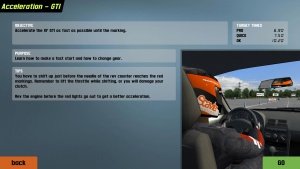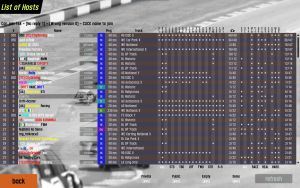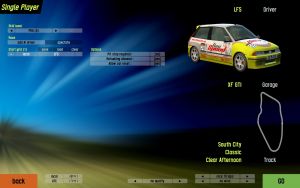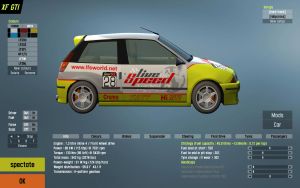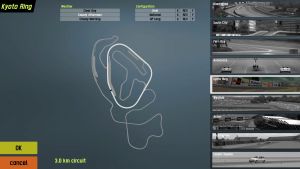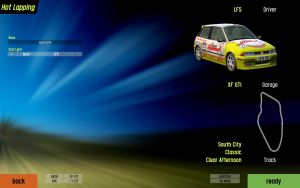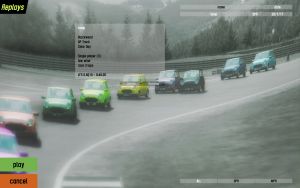Différences entre versions de « Modes de jeu »
| Ligne 54: | Ligne 54: | ||
FZR - FZ 50 GTR (S2) | FZR - FZ 50 GTR (S2) | ||
| − | ''' | + | '''codes des circuits:''' Les cirsuits sont égalements identifiés sur la liste des serveurs par des codes listés dans le tableau suivant. Chaque configuration de circuit à l'expetion des "drag strips" peut etre courru dans le sens normal ou en sens inverse, en doublant ainsi le circuits. Le code de circuit est une combinaison de trois parties: 1. identifiant du circuit, 2. Numero de la configuration and 3. Drapeau de sens inverse. Exemple: BL1R Signifie "Blackwood GP Sens inverse", AS3 pour "Aston National", etc. |
BL - Blackwood (3 configs: GP, RallyX, Car Park) | BL - Blackwood (3 configs: GP, RallyX, Car Park) | ||
Version du 22 décembre 2006 à 08:35
Entraînement
Le nouveau mode d'entraînement de Live For Speed est identique à une école de conduite qui aidera tout nouveau pilote de Live For Speed à « auto-aquérir » les techniques nécessaires aux courses sur circuits. Bien sur pour les vétérans de Live For Speed l'entraînement peut être bénéfique pour affiner leur style de conduite. Choisissez une des leçons de la liste et sur l'écran suivant vous trouverez les instructions sur ce qu'il vous faudra faire pour valider le test. Après avoir fini l'exercice, LFS vous indiquera la performance que vous avez obtenue.
Toutes les leçons doivent être terminée en un temps imposé et sans toucher aucun des cônes, sinon la course n'est pas validée. En cliquant sur le bouton multiplayer vous emmènera vers votre carrière virtuelle "en ligne". Quand vous êtes "en ligne" vous devez toujours vous souvenir que vous courrez contre des adversaires humains et que vous devez vous comporter avec courtoisie. Conduisez prudemment et essayez d'éviter les accidents. Conduire proprement vous apportera non seulement de meilleures courses, mais vous aidera également à trouver des adversaires qui veulent courir avec vous. La façon la plus rapide de commencer et de cliquer sur 'liste des serveurs' et de choisir une des nombreuses courses "en ligne" disponibles. Bien sur il existe des options supplémentaires qui vont être clarifiés dans la suite de ce manuel.
Multijoueur
Multijoueur Menu Principal
Mode en ligne: Ce mode vous permet de choisir si vous voulez courrir en version Demo, S1 ou S2. Aprés avoir choisi Démo, LFS se comportera comme si vous avez la version demo installée. Vous pourrez uniquement courrir avec des voitures de la Démo, sur des circuit de la Démo et le nombre de courreurs maximum sera limité à 11. Cette option est utile si vous voulez vous mesurer à un ami qui n'as pas (encore) acheté LFS. Quand vous créez un serveur quand le mode Demo est activé, seulement les courreurs utilisants la Démo ou les courreurs ayant activé le mode Démo, pourront voir et rejoindre votre serveur W. Bien sur vous pouvez passer du mode S1 ou S2 aussi souvent que vous voulez sans avoir à deverouiller LFS de nouveau.
Connecter en mode fenêtré: Quand cette option est activée, LFS basculera en mode fenètre lors de la connection. Cette option est utile quand vous avez besoin de vous connecter manuellement à internet ou lorsque vous avez un firewall qui vous affiche un message lorsque LFS veut envoyer des données au serveur maitre. Lorsque votre ordinateur se connecte automatiquement à internet ou que LFS est autorisé à communiquer avec internet vous pourvez, bien évidement, désactiver cette option.
Chercher un joueur: Comme chaque joueur de Live For Speed à un nom unique, vous pouvez effectuer une recherche de chaque joueur jouant à LFS. Vous avez uniquement à saisir le nom du joueur que vous cherchez et, si le joueur est "en ligne" LFS vous demandera si vous voulez le rejoindre sur le serveur.
Afficher la liste des parties online
Aprés avoir cliqué sur ce bouton LFS va connecter au serveur maitre et télécharger la liste de tous les serveurs Live For Speed disponibles qui ne sont pas cachés. La liste contient des informations sur chaque serveur tel que quelles voitures sont autorisées, quel circuit est utilisé et combien de coureurs sont en course sur le serveur. En cliquant sur le bouton "?" vous ferez apparaitre différentes informations tels que le nom des coureurs dans la fenètre de chat. En utilisant les boutons du bas de l'écran vous pouvez spécifier les critères d'affichage des serveurs.
Filtre de voiture: Le filtre de voiture vous aide à trouver le serveur que vous voulez.
La méthode rapide pour utiliser les filtres: Utilisez les boutons de catégories de voitures sur la partie droite de l'écran pour appliquer rapidement différents filtres de voitures. "ALL" est le filtre par défaut. Pour affiner le réglage ou faire un réglage manuel: Cliquez sur les noms des vèhicules en titre de colonne dans la liste des parties. Vous pouvez faire basculer les titres en gris, bleu ou rouge.
GRIS : Vous ne vous préocupez pas de savoir si cette voiture est autorisée sur le serveur ou pas
BLEU : Cette voiture doit être autorisée sur le serveur
ROUGE : Cette voiture doit être interdite sur le serveur
- Laissez le maximum d'entre eux GRIS (la couleur par défaut)
- La voiture que vous voulez utiliser doit être en BLEU
- Utilisez le ROUGE uniquement pour les voitures que vous ne voulez pas voir
Joueurs : Rejoignez des serveurs vide - les autres vous rejoindrons!
Serveurs : S'il vous plait, autant que possible n'autorisez pas toutes les voitures.
Codes des voitures : Dans la liste des serveurs vous trouverez des codes représantants les voitures autoriseés à courrir sur le serveur. La liste suivante contient la liste des voitures disponibles dans la S2:
UF1 - UF 1000 (S2) XFG - XF GTi (Demo, S1, S2) XRG - XR GT (Demo, S1, S2) XRT - XR GT Turbo (Demo, S1, S2) RB4 - RB4 GT (S1, S2) FXO - FXO Turbo (S1, S2) LX4 - LX4 (S1, S2) LX6 - LX6 (S1, S2) FZ5 - FZ 50 (S2) RAC - RaceAbout (S2) MRT - MRT5 (S1, S2) UFR - UF 1000 GTR (S2) XFR - XF GTR (S2) FOX - Formula XR (S2) FO8 - Formula V8 (S2) BF1 - BMW Sauber (S2) FXR - FXO GTR (S2) XRR - XR GTR (S2) FZR - FZ 50 GTR (S2)
codes des circuits: Les cirsuits sont égalements identifiés sur la liste des serveurs par des codes listés dans le tableau suivant. Chaque configuration de circuit à l'expetion des "drag strips" peut etre courru dans le sens normal ou en sens inverse, en doublant ainsi le circuits. Le code de circuit est une combinaison de trois parties: 1. identifiant du circuit, 2. Numero de la configuration and 3. Drapeau de sens inverse. Exemple: BL1R Signifie "Blackwood GP Sens inverse", AS3 pour "Aston National", etc.
BL - Blackwood (3 configs: GP, RallyX, Car Park) SO - South City (5 configs: Classic, Sprint 1, Sprint 2, City Long, Town Course) FE - Fern Bay (6 configs: Club, Green, Gold, Black, RallyX, RallyX Green) AS - Aston (7 configs: Cadet, Club, National, Historic, Grand Prix, Grand Touring, North) WE - Westhill (1 config : International) KY - Kyoto (3 configs: Oval, National, GP Long) AU - Autocross (4 configs: Autocross, Skid Pad, Drag Strip, 8 Lane Drag)
Info codes: Each server on the list has a info column which provides a quick overview of how the server is set up, using six different characters to indicate the settings.
V - Voting (for kick/ban) is allowed S - Selecting the track is allowed Q - Qualifying is possible (otherwise only race) M - Mid-race join is enabled P - Pit stop is mandatory R - Host is connected to the Insim Relay
Chat: When you click the chat button a chat window will be displayed above the serverlist. This allows you to meet other racers and arrange races or just chat a bit. Like in IRC there are a few commands you can use:
/find [username] – will show if the user is online at the moment just like the 'Find User' button.
/users – will show how many users are online at the moment.
/hosts – will show how many hosts are online at the moment.
/me [text] – displays an action of yourself.
/leave – closes the chat just like the 'Leave' button.
/help – shows a list of all chat commands.
Join specific game
This option helps you to join a specific server, for example a team or racing series server, without having to browse the serverlist before. Everytime you click on 'Join specific game', the last server you raced on will be preset. This makes it possible to rejoin a server that you have been disconnected from within a few seconds.
Type of Server: Here you can choose if the server is for a LAN or an Internet session. The LAN option allows up to 3 players racing each other while using the same LFS-Username. This makes it possible to arrange small LAN parties even if not all players have bought Live for Speed. Within the demo mode, the LAN option also can be choosen when the IP of the server is known and you do not want LFS to connect to the master server. The option 'Internet' will make LFS automatically connect to the master server. This way, entering the server's name is enough information to establish a connection but a single user name can only be onlíne once.
Servername: Entering the server's name will connect you directly with the server. Capitalisation and colours are ignored.
Server Password: Some servers are not opened to the public as they serve specific purposes like team practice or racing series events. These servers are usually protected by a password which you can enter here. Many servers, even public ones, have set up an admin password. If you enter this admin password, you will be allowed to change certain server-settings by using specific chat-commands (see key-commands). Capitalisation is generally ignored but colours have to match.
Server IP-Address: After choosing LAN as server type, you can enter the server's IP-Address here.
Server Port: The default server port is 63392 and usually does not need to be changed. If, for some reason, the server does not use the default port, you can specify the correct port here.
Start new game
Of course you can open your own server for Live for Speed. The possible number of players who can race on your server primarily depends on the upload bandwidth of your Internet-connection. The integrated Bandwidth calculator will help you to determine how many racers you should allow to connect. Generally there are two different types of server. The first is the standard server which you run on your computer while racing yourself. The second is the so called dedicated server which does not offer ingame graphics and only allows others to connect to your server. For both server types there are various server options which will be described below.
Type of server: This is pretty much the same as in 'Join specific game' but has the additional option 'Hidden'. A hidden server will be logged in on the master server but not visible on the player's server list. Only players that know the exact server name will be able to connect to the server.
Servername: This is the name of your server, which will show up in the server list, or if the server is hidden has to be manually entered by the racers that want to connect.
Server Password: Entering a password into this line will change the server from a public into a private server. Only racers knowing the password will be able to connect. Leaving this line empty will allow everyone to connect.
Administrator Password: Entering an administrator password will allow a remote administration of the Live for Speed server. A racer who connected using the admin password will be allowed to change certain server-settings using a set of chat commands.
IP-Address: If the server has more than one IP-Address you can specify which address should be used by the LFS-Server.
Port: Specifies which port the server should use to connect to the Internet. Usually this can be left at the default value 63392.
ADVICE: If the server connects to the internet through a firewall the TCP and UDP ports which are used by LFS (default: 63392 and 29339) have to be forwarded (http://portforward.com/routers.htm) to the server.
Internet connection: The optimal maximum number of players on your server depends on the upload bandwidth of your Internet connection. Just choose the correct entry from the list.
Maximum Upload: If the upload bandwidth of your internet connection does not match one of the entries in the list you could choose from under the option 'Internet connection' you can manually enter the correct value here. The value has to be in kBit/s.
ADVICE: If you only know your upload bandwidth in kByte/s or Mbyte/s you will have to convert it to kBit/s:
1 kByte/s = 8 kBit/s
1 MByte/s = 8 MBit/s
Maximum number of Guest PCs: This is the maximum number of PCs that will be allowed to connect to your server. This number does not necessarily match the number of racers that will be able to race on your server.
Maximum cars in race: This is the maximum number of cars that will be allowed to race on your server. This includes human racers as well as the AI.
Maximum cars per guest: This is the maximum number of cars every single guest PC might run on your server. This includes human racers as well as the AI.
Maximum cars on host: This is the maximum number of cars you will be able to race on your server.
Packets per second: Every second all the connected PCs receive data packets from the server which inform them about the positions of all the cars on the track. The more packets per second the PCs receive the more fluent the movement of all the other cars will be and thus the simulation will simply be more immersive. This value determines how many packets per second will be sent which hugely depends on the upload bandwidth of your internet connection. You should always try to keep this value as high as possible.
Dedicated: If you are using a PC to run the server, which does not offer enough 3D performance to properly run LFS in full graphic mode you can choose to run a so called dedicated server which only shows a summary of the connection. You will not be able to directly follow the race but you can still chat with the racers.
Allow vote (Kick/Ban): LFS allows the racers to kick or ban another racer by voting to do so. This has proven to be a good way to prevent people to destroy the races of others on purpose. If this option is set to 'No' only the server administrator will be allowed to kick or ban other racers.
Allow track: If set to 'Yes' this allows the connected to choose the track they want to race on, otherwise only the server adminitrator will be allowed to choose a different track.
Singleplayer
Even though Live for Speed was developed to offer the best online racing possible, its single player mode is not only a necessary addition but also very usefull in different aspects. The single player can be used to learn new tracks, develop setups or even practice some overtaking against the learning AI. If you make a mistake in single player mode, you will never anger anyone – except yourself, perhaps.
Skill Level: The speed of the AI can be varied from Beginner to Pro. Remember that the AI improves while racing and thus gets faster. On some tracks, the AI might be more than 5 seconds faster after an hour of racing. Every single AI behaves a little different so racing them will never get too boring.
Add AI driver: You can add up to 12 AI driver to the race.
Join Race: This allows you to enter the race yourself. If you have already added 12 AI drivers to the race, you will not be allowed to join yourself as 12 is the maximum number of racers allowed.
Start Grid: This is a list of all participating drivers. Clicking on a drivers name will select this driver, clicking on the '-' in front of the name will remove the driver from the grid.
Swap Position: This button will only be visible when an AI has been selected from the grid. When you click on this button you will swap position with the selected AI in the grid.
Player: This button directly takes you to the player's options, allowing you to change the name, the driver model you use and your nationality.
Garage: This button takes you to the pits where you can set up and tune your car.
Track: This button lets you choose the track, its configuration, the weather and the time of day.
Laps: The grey buttons allow you to choose how many laps you want to race. Choosing 0 laps will start an unlimited practise session which probably is the best way to learn new cars and tracks as you can do as many timed laps as you want. Additionally, this is the mode that allows you to train your AI over night. As soon as you select 1 or more laps to race, an additional control appears which lets you choose if you want to have a qualifying before the race and how long it should be. Right below the number of laps you can select how much wind you want to have. There are three levels of wind: none, low and strong. The direction and the actual strength is set by a random function.
INFORMATION: The number of laps is limited to a max of 255.
ADVICE: Right-Clicking on the buttons will change the value in steps of 10.
Game Lobby Screen
In the game lobby screen you will set up your single and multiplayer races. Here you can choose your car, including it's skin and setup, the track and set up how long you want to race.
Let’s examine the buttons you can access and their usage. You can see a skill level button labelled pro with an arrow at each end, this button controls the level of intelligence for the AI (Artificial Intelligence) clicking on the left arrow lowers the value, the right increases the value, newbie is the lowest value and starting point, pro is the highest level.
The next button under the skill level is the add AI button this adds a robot car to LFS ready to race against you or against another AI car or the clock; up to twelve AI can race at any one time or eleven AI against you, the racer in offline mode. AI racing is fun and a great way to learn the tracks, racing lines etc., AI can consist of different cars against each other, due to similar outputs and abilities many LFS racers have pitted the GTi against the GT and close racing & great spectator fun has always ensued.
The join race button is self explanatory; this allows you to add your car, manned by you and join in the fun. Looking now to the group of buttons to the right of the screen, we see that the next button is called the player button.
Garage Area and Car Settings
Next we have the main screen you probably will deal with in LFS, this is the garage area, it is here you select your car type, create, add and delete setups and modify all kinds of stuff. Most of these buttons are very easy to figure out and largely self-explanatory, starting from top left we see the car colours panel.
The car colours panel allows you to add, delete and modify the colour schemes of your own prepared skins and some LFS supplied skins. Clicking on the individual colour icon, or using the new button to add a new named skin to the list, from a pop up selection of named skins in the LFS/skins folder.
Under the colour panel is the driverand force panel, this allows you to turn on force lines to show the level of force on the car and add a driver and rotate and bounce the car. Have a play around with it and see the difference stiffer suspension, driver weight, has etc.
The vertical row of buttons (right) contain your car setups for the pictured car type, to change car selection you select the car button. The new button will allow you to make a copy of the currently selected setup, (you then make changes to the new one preserving the original) delete removes the selected setup from the list and LFS.
The most important part on this screen is the horizontal row of car setup buttons, as the naming suggests you can alter the settings of many components here. Info is the only one that cannot be changed, it merely provides info about each car in terms of specifications regarding weight, power output etc.
This whole area has its own separate guide to allow you get the most out of the ability to customise your car for optimum performance and fun. However, briefly, you will notice that all sub menus have sliders to increase or decrease the selected values. Using the sliders you may also right-click on any slider to directly type in the value or you can copy and paste values with Strg-right-click and Shift-right-click respectively.
Make a copy of the default hard track setup by highlighting it, click new to create a copy and save under a different name and play around with the settings by increasing or decreasing items, use small adjustments at first etc, when finished click OK to return to the Single Player screen and add to race by clicking the join race button.
Track Selection
Next we will cover the last button the tracksselection button, pretty important as we need a safe place to race our cars, hey? You will see a small map showing the selected track from an overhead view and details on the overall length of that track, next to the tracks button are buttons that set the type of race at the selected track, the race length and wind speed if any. They are:
Qualifying, this sets the qualifying time in minutes or can be disabled so there is no qualifying for this race race 1, this shows the selected number of laps in the current race, This can be as high as 255 laps or as low as 1 lap, also decreasing the counter to zero sets the session to practice, this is an untimed free session.
Wind has three settings, no wind, low wind and high wind. The wind direction and speed is randomized by LFS and it will have a noticable impact on your laptimes!
There are six major track areas for racing, the sevenths area Autocross is a skid pad zone for building tracks and experimenting, as well as a two and eight lane drag strip area. To use a track, simply select the desired track from the main areas on your right, this will bring a submenu containing all the tracks available for that particular raceway. You can then choose which of the separate tracks to race on by clicking on that track name. A map showing the track layout is then displayed, and options to change the weather conditions (lighting only) are available from the weather menu, with its three options:
BRIGHT CLEAR - OVERCAST - CLOUDY SUNSET/DUSK - You have to make the choice! At this stage of LFS development actual weather conditions, such as rain, hail, fog etc have not been implemented, nor has night racing.
Clicking the OK button will lock in the selected track and options you have chosen and return you to the Single Player selection screen where you can join the race and start racing by clicking the GO button.
Hotlapping
In hotlapping mode you can try to compete with the best drivers in the world without even going online.
This mode puts you on the track in a controlled and perfect environment and lets you fight against the clock. But you should be careful not to leave the road or hit an object while trying to improve your lap times as the HLVC (HotLap Validity Check) will constantly watch what you are doing and mark any lap as invalid which was not clean. In the top right corner of the screen you will see the fastest valid lap you have done and the last split times you did. After you have done a lap that was a personal best and that was marked as valid by the HLVC, you can upload it to http://www.lfsworld.net, compare your time to the official world-record time and see how you rank against all the other racers out there.
Saved replays you can find in data\spr folder. Best way to save replay is to press '1' key, this saves replay file with automatic name in format youraccountname_track_car_time.spr, eg. somebody_AS1_UF1_10883.spr. To name replay file yourself, press '2' key. To upload a replay, open S2 Hotlaps in LFS World, and go to tab Hotlap Charts.
You can access the hotlap database from online game, see 'LFS World statistics commands for in-game usage'.
TIP: Replays of all the laps that have been uploaded to LFS World can be downloaded and then watched on your PC. This is the perfect way to study the racing line of the world's best drivers and improve your own laptimes.
Replays
One of the great features of LFS is the ability to record a replay of each race, whether it be a Single Player Race (SPR) or a Multiplayer Race (MPR, LAN or Online). Watching a replay you can use various camera-perspectives, speed-up, slow-down or even pause the play back. The appropriate hotkeys are listet in the key commands chapter. To record a race it is customary to set this feature in the Options/Game section as we discussed before, however you can save a recorded session by hitting the 1 key on the main keyboard , this saves the race up until that point and immediately starts the saved replay playing back, this is useful when you have just finished an online race and want to save it before everyone restarts.
During a single player replay, if you hit the esc key, you will be presented with some options:
Options: Takes you to main options screen
Replay: Restarts the selected replay
Output lap data: Saves technical information to a .RAF (Repay Analyser File) that you import into external programs, such as Analyse For Speed or F1PerfView available from the Live For Speed main site.
Test drive: This allows you to drive using someone’s replay file. Say you dl a World record holders replay and want to see how you do in their car! You may have to change your controller settings to suit if they use a wheel and you use kbd etc .first.
